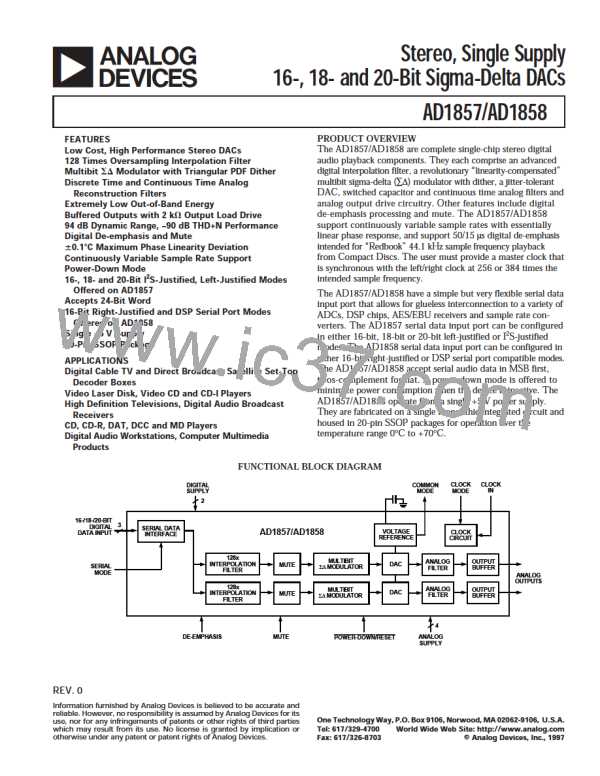AD1857/AD1858
D EFINITIO NS
Inter channel Gain Mism atch
D ynam ic Range
With identical near full-scale inputs, the ratio of outputs of the
two stereo channels, expressed in decibels.
T he ratio of a full-scale output signal to the integrated output
noise in the passband (0 kHz to 20 kHz), expressed in decibels
(dB). Dynamic range is measured with a –60 dB input signal
and is equal to (S/[T HD+N]) + 60 dB. Note that spurious
harmonics are below the noise with a –60 dB input, so the noise
level establishes the dynamic range. T his measurement tech-
nique is consistent with the recommendations of the Audio
Engineering Society (AES17-1991) and the Electronic Industries
Association of Japan (EIAJ CP-307).
Gain D r ift
Change in response to a near full-scale input with a change in
temperature, expressed as parts-per-million (ppm) per °C.
Cr osstalk (EIAJ Method)
Ratio of response on one channel with a zero input, to a full-
scale 1 kHz sine-wave input on the other channel, expressed in
decibels.
Inter channel P hase D eviation
Total H ar m onic D istor tion + Noise (TH D +N)
T he ratio of the root-mean-square (rms) value of a full-scale
fundamental input signal to the rms sum of all other spectral
components in the passband, expressed in decibels (dB) and
as a percentage.
Difference in output sampling times between stereo channels,
expressed as a phase difference in degrees between 1 kHz
inputs.
P ower Supply Rejection
With zero input, signal present at the output when a 300 mV
p-p signal is applied to power supply pins, expressed in decibels
of full scale.
P assband
T he region of the frequency spectrum unaffected by the
attenuation of the digital interpolation filter.
Gr oup D elay
P assband Ripple
Intuitively, the time interval required for an input pulse to
appear at the converter’s output, expressed in seconds(s). More
precisely, the derivative of radian phase with respect to radian
frequency at a given frequency.
T he peak-to-peak variation in amplitude response from equal-
amplitude input signal frequencies within the passband,
expressed in decibels.
Stopband
Gr oup D elay Var iation
T he region of the frequency spectrum attenuated by the digital
interpolation filter to the degree specified by “stopband
attenuation.”
T he difference in group delays at different input frequencies.
Specified as the difference between the largest and the smallest
group delays in passband, expressed in microseconds (µs).
Gain Er r or
D e-Em phasis Gain Er r or
With a near full-scale input, the ratio of actual output to
expected output, expressed as a percentage.
A measure, expressed in decibels, of the difference between the
ideal 50/15 µs de-emphasis filter response, and the actual 50/15 µs
de-emphasis filter response.
–6–
REV. 0

 ADI [ ADI ]
ADI [ ADI ]